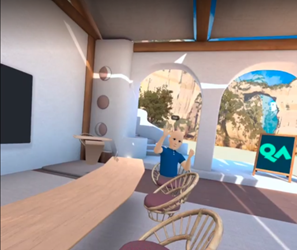Our first steps into training in a virtual world
Over the last few months, Phil C (Microsoft Guru at QA) and I, have been exploring the use of VR setups for training courses. Headsets, mixed reality, virtual reality and video attendees.
These virtual environments include floor 23 of an office block in a busy metropolis, a mountain retreat and a beach front (definitely our favourite… we’re sure we could hear the seagulls).
This got us thinking about the logistics of running full-on training sessions in virtual reality. Not just could it be done, but should it be done.
The logistics of training in VR
For starters, here we are talking about instructor-led sessions. Real time deliveries, not pre-recording or AI run events.
There are so many things that stand out straight away within minutes of considering running a training session across a VR environment, such as people needing;
- Enough battery power.
- Perfect 20/20 vision without glasses?
So, what would the average learner need to attend a training course within a virtual reality space?
Firstly, an appropriate VR headset, allowing them to connect to a live video session. However, this element alone poses a few key questions and challenges.
Does a VR headset bring anything different compared to a standard 2D video conferencing call? What about the cost of the headset? What about users who wear glasses, or those struggle with motion sickness? Would learners need to wear the headset for whole days at a time… or a whole week?
As with any new technology, the actual application of these devices is far from thought out or perfected.
This is before getting into more technical considerations, such as the reliability of the hardware, familiarity of supporting handheld devices and configuration of hand-mapping. Delegates may also need to connect social media accounts, and create avatars.
If your haircut is as complex as mine and Phil’s, this can take time…
![]()
‘Would we end up with a them and us environment?’
Then we also started thinking about people attending – as we mentioned, what if people don’t have a headset? Is the experience as immersive? Is it actually negative compared to a regular video conferencing session? Would we end up with a bit of a ‘them and us’ environment ‘ the ‘have and have nots’?
Based on what software is being used to host the virtual training environment people would also need installation, exposure, and accounts here too – before the actual training event…whoa, this list of pre-req requirements before anyone has gotten anywhere near the session is growing and growing.
Now don’t get me wrong, we love the idea of new and exciting ways that we could bring content to learners. When Phil and I ran our first internal VR session we thought it was ACE! so, encapsulating, so ‘together’ – in this increasingly separated world, but we have to consider the practical element too – is the commercial, non-medical, non-engineering side of training ready for VR classes?
The ’could’ or VR training is still up for debate… but what about the ‘should’?
How to host virtual reality training

One of the key questions is which app should be used to host the session.
There are so many VR providers that promise an environment conducive to all learning needs etc. Some can host five attendees; some can host hundreds.
An app that Phil and I settled on to try first, with the Oculus 2 headset was Horizon Workrooms. The screenshots above were from our very first session, it took literally minutes to setup the virtual room, tweak the environment a little – to add the QA branding etc (except the blue, graffiti looking QA where I had to add a transparent background – as someone without an artistic bone in their body this took a few more minutes).
I don’t want to turn this into a Horizon Workrooms fan boy session but it’s is pretty cool. Switching around the room, importing your monitor, keyboard and mouse into the session was pretty straight forward. Sharing your screen as a virtual projector session was nice too – with the learners obviously turning between me at the lectern and the projected content – in this case it was the beginning of an AWS Architecting class.
In the Workrooms app you can also switch the projected slides into a board session too. So, the avatar me – who my son tells me would be ‘scary’ if he had to attend a session for a whole day watching, (nice – thanks, mate) – can draw diagrams and highlight content for the attendees to see. In a training room kind of style. Avatar ‘me’ can use post it notes and invite others up to the board too, to collaborate and share with other learners.
To setup a session we went through some basic steps of;
- Installing the Workrooms app.
- Creating a Workrooms account.
- Pair the headset and device presenting from (in my case Windows 10 laptop).
- Give the workroom a name.
- Invite attendees.
Now, before we get carried away and start championing how easy and straight forward it all is some aspects of the ‘basic steps’ do actually have a few pre-reqs that we need to address.
In order to ‘pair’ and ‘insert’ your pc with the workroom so that you can access it from within the session, and in my case use to present content on the virtual projector, you need to install the remote desktop app, this is in addition to the Workrooms app on the headset.
You will also need to ‘scan’ your desktop space and the space that you will be using for the board too. The home office I present from remotely isn’t the biggest, so I found finding an empty area to act as my board a little tricky. Scanning it was fine but the whole time I am standing at the virtual board and drawing (whilst wearing the headset) I am just waiting to bang my knuckles on the physical bookshelf that, in reality is millimetres away from my virtual board border.
So, the ‘should’ aspect here is definitely feasible with a little investment from the software and hardware perspective, the thing is though is it really relevant for a tech-based training class? I currently deliver Citrix and AWS based courses; would they benefit from being presented in a Workroom environment? What would it bring to the learners on top of a regular video based session, with apps like Teams, Zoom, Webex becoming increasingly feature rich, is it worth it?
In the interests of being transparent I am not 100% sure I can wholeheartedly say yes. But could that change in the future?
Could VR replace traditional instructor led-training?
While virtual reality (VR) training has the potential to revolutionize the way we learn, it is unlikely that it will completely replace traditional classroom learning. Here are some reasons why:
- Cost: While VR can save costs in certain areas such as travel and equipment, it can be expensive to develop and maintain the technology and software required for VR training. Traditional classroom learning can be more cost-effective in some cases, especially for smaller groups or individuals.
- Social Interaction: Traditional classroom learning provides face-to-face interaction with instructors and fellow students, which can be important for building relationships and collaborative learning. VR training can lack this interpersonal component, leading to a potential loss of social interaction.
- Limited Subject Matter: VR training is best suited for hands-on and practical training, while theoretical and academic topics may not be well-suited for VR. Traditional classroom learning can offer a wider range of subject matter options and flexibility in the delivery of the content, though AR/MR will almost certainly be incorporated to add unprecedented capabilities to classroom learning.
- Accessibility: VR training requires specialized equipment and software, which may not be accessible to all learners. Traditional classroom learning is more accessible, as it only requires basic tools such as books, pen and paper, or a computer.
However, VR training can be highly effective for certain types of learning, especially for practical skills and simulations. It can provide an immersive and interactive learning experience that allows trainees to practice skills in a safe and controlled environment. As such, VR training can complement traditional classroom learning and be used in combination with other teaching methods to provide a well-rounded learning experience.
How can we see this technology being used in QA tech lead course deliveries?
 If not used to host a whole session, could the team building aspects of these kinds of VR apps help me deliver a vendor, or even QA produced technical training session?
If not used to host a whole session, could the team building aspects of these kinds of VR apps help me deliver a vendor, or even QA produced technical training session?
Maybe they could serve as a breakout session or a break time distraction – but surely this time should be making the most out of none ‘screen’ or ‘VR’ time?
Personally I think my conclusion is that the whole concept is great for the medical training space, for the engineering arena, for universities and colleges teaching history, biology and topics that people would struggle with access to in their everyday life. For the technical ‘Cloud and Virtualisation’ and ‘Infrastructure and Networking’ area that I currently deliver in, not so much.
How much extra would this technology bring to my learners on top of the current in person or remote deliveries that QA offer? How much more, as an instructor could I add to my sessions (taking into account all the requirements and setup) that I couldn’t offer with a board to draw on and an environment to demonstrate in?
One of the things this ‘experiment’ has proven to me is that I really want a training room on the beach! I really want a room where my learners and I could cover AWS Architecting module 2 on IAM and then take a break, build a sandcastle and take a swim, sounds perfect.
Wait! Can I change my answer?
Training sessions hosted in a Virtual Reality world ARE the future – quick where are my swimming trunks?
Browse all training courses at QA


